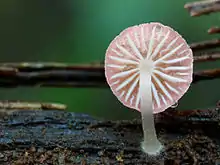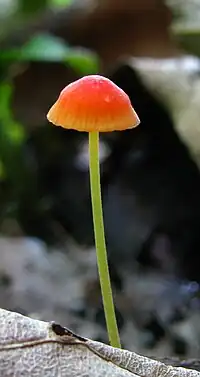| Atheniella adonis | |
|---|---|
 | |
| Scientific classification | |
| Domain: | Eukaryota |
| Kingdom: | Fungi |
| Division: | Basidiomycota |
| Class: | Agaricomycetes |
| Order: | Agaricales |
| Family: | Cyphellaceae |
| Genus: | Atheniella |
| Species: | A. adonis |
| Binomial name | |
| Atheniella adonis (Bull.) Redhead, Moncalvo, Vilgalys, Desjardin & B.A. Perry | |
| Synonyms | |
|
Agaricus adonis Bull. | |
| Atheniella adonis | |
|---|---|
| Gills on hymenium | |
| Cap is conical | |
| Hymenium is adnate | |
| Stipe is bare | |
| Spore print is white | |
| Ecology is saprotrophic | |
| Edibility is inedible | |
Atheniella adonis, which has the recommended name of scarlet bonnet in the UK,[1] is a species of agaric in the family Cyphellaceae. Found in Asia, Europe, and North America, it produces small orangish to reddish mushrooms with caps up to 1.2 cm (0.5 in) in diameter and thin pinkish-white stems reaching 4 cm (1.6 in) long. The fungus typically grows in conifer woods and peat bogs, suggesting a preference for acidic environments. The appearance of several atypical fruitings on deciduous wood in the Netherlands in the late 1970s was attributed to increases in atmospheric pollution that raised the acidity of the wood substrate.
Taxonomy
The species was first named Agaricus adonis in 1792 by Jean Baptiste François Pierre Bulliard,[2] and placed in Mycena by Samuel Frederick Gray in 1821.[3] Rolf Singer successively moved it to Hemimycena (1943),[4] then Marasmiellus (1951).[5] Singer later changed his mind about these placements, and his 1986 Agaricales in Modern Taxonomy, he considered the species a Mycena.[6]
Recent molecular research, based on cladistic analysis of DNA sequences, has shown that the species is not closely related to Mycena and belongs in the Cyphellaceae in the genus Atheniella.[7]
Etymology
The species epithet refers to the handsome youth Adonis in Greek mythology. Samuel Frederick Gray called it the "Adonis high-stool" in his 1821 Natural Arrangement of British Plants,[3] while Mordecai Cubitt Cooke named it the "delicate Mycena".[8]
Description

The cap initially has a sharply conic shape, but expands to a narrow bell-shape or a broad cone in maturity, typically reaching 0.5 to 1.2 cm (0.2 to 0.5 in) in diameter. The cap margin, which is initially pressed against the stem, is opaque or nearly so at first. It is scarlet red when fresh and moist, becoming orange or yellowish orange before losing moisture. The mushroom is hygrophanous, and fades to an orange buff when dry. The flesh is thin, the same color as the cap, fragile, and without any distinctive taste or odor. The gills are ascending-adnate (the gills attach at much less than a right angle, appearing to curve upward toward stem) or attached by a tooth, subdistant to close, with 14–16 gills reaching the stem. Additionally, there are two or three tiers of lamellulae—short gills that do not extend fully from the cap edge to the stem. The gills are narrow, and yellowish or with a reddish tinge at first; the margins are paler and the same color as the faces. The stem is 2–4 cm (0.8–1.6 in) long and 1–2 mm (0.0–0.1 in) thick, and roughly equal in width throughout. It is tubular, fragile, initially pruinose (covered with a fine powder), polished and smooth with age, pale yellow, becoming whitish, with the base often dirty yellow or brownish.[9]
Microscopic characteristics
The spores are narrowly ellipsoid, inamyloid, and measure 6–7 by 3–3.5 μm. The basidia (spore-bearing cells) are four-spored and measure 20–22 by 6–7 μm. The cheilocystidia and pleurocystidia (cystidia found on the edges and faces, respectively, of the gills) are abundant and similar in shape and markings, 40–58 by 10–15 μm, tapering somewhat on either end and usually with a long needle-shaped neck (which is branched in some). The cystidia are generally smooth, but when dried material is mounted in potassium hydroxide for observation under light microscopy, an amorphous substance apparently holds spores and debris around the neck or apex, making them appear encrusted. The flesh of the gill is very faintly vinaceous-brown when stained in iodine. The cap flesh has a thin, poorly differentiated pellicle with a region of slightly enlarged cells beneath it; the remainder is filamentous, and the filamentous portion stains vinaceous-brown in iodine.[9]
Similar species

Mycena acicula is typically smaller with a deep orange-red cap rather than the typical bright salmon-pink of A. adonis. Since the colors and sizes of M. acicula and A. adonis are similar, a microscope is needed to reliably distinguish between them, with spore size and shape being different. Mycena strobilinoides can be distinguished by its orange cap and amyloid spores. Atheniella aurantiidisca can be distinguished by its lack of scarlet to pinkish tones in the cap and lack of gelatinized cortical hyphae. Mycena oregonensis is differentiated by its orange to yellow cap and lack of scarlet to pinkish tones.[10] Mycena roseipallens has a smaller fruit body, wider spores, a less intensely colored and less conical cap, and grows on the decaying wood of elm, ash, and alder.[11]
Ecology, habitat and distribution
The fruit bodies of A. adonis grow solitarily or in groups in conifer forests and heaths, and appear in the spring and autumn. The fruit bodies grow in groups or scattered on needle beds under spruce and hemlock in wet coastal conifer forests, or in the higher mountains, where it is not uncommon in the spring and autumn months. In one instance, fruit bodies were found growing on the deciduous trees Spanish Maple (Acer granatense) and willow (Salix alba) near Amsterdam. It was hypothesized that the bark of these trees had become more acid in recent years because of increasing atmospheric pollution (specifically, increases in the levels of sulfuric and nitric acid from industrial smoke), providing a more suitable substrate for the fungus.[12]
The fungus is found in Europe[13] and in western North America,[14] where Mycena specialist Alexander H. Smith found the species in Washington, Oregon, and California.[9] In 2007, it was reported from the valley of the Ussuri River in the northeast of China.[15]
References
- ↑ Holden L. (April 2022). "English names for fungi 2022". British Mycological Society. Retrieved 2023-05-06.
- ↑ Bulliard JB, Ventenat EP (1792). Histoire des champignons de la France, compl., pl. 369-372, 509-540 (in French). Vol. 2. Paris. pp. 445–46. Retrieved 2010-06-01.
- 1 2 Gray SF. (1821). A Natural Arrangement of British Plants. p. 620. Retrieved 2010-09-24.
- ↑ Singer R. (1943). "Das System der Agaricales. III". Annales Mycologici. 41: 123.
- ↑ Singer R. (1949). "The Agaricales in modern taxonomy". Liloa. 22 (2): 123.
- ↑ Singer R. (1986). The Agaricales in Modern Taxonomy (4th ed.). Koenigstein: Koeltz Scientific Books. p. 413. ISBN 3-87429-254-1.
- ↑ Vizzini A, Consiglio G, Marchetti M, Borovička J, Campo E, Cooper JA, Lebeuf R, Ševčíková H. (2022). "New data in Porotheleaceae and Cyphellaceae: epitypification of Prunulus scabripes Murrill, the status of Mycopan Redhead, Moncalvo & Vilgalys and a new combination in Pleurella Horak emend". Mycol Progress. 21 (4). doi:10.1007/s11557-022-01795-z.
{{cite journal}}: CS1 maint: multiple names: authors list (link) - ↑ Cooke MC. (1871). Handbook of British fungi, with full descriptions of all the species, and illustrations of the genera. London: Macmillan and co. p. 66. ISBN 978-1-110-35673-7. Retrieved 2010-09-27.
- 1 2 3 Smith, pp. 177–78.
- ↑ Wood M, Stevens F. "Mycena adonis". California Fungi. MykoWeb. Retrieved 2010-09-24.
- ↑ Smith AH. (1936). "Studies in the genus Mycena. III". Mycologia. 28 (5): 410–30. doi:10.2307/3754114. JSTOR 3754114.
- ↑ Reijnders J. (1977). "Mycena adonis as a deciduous tree epiphyte". Coolia (in Dutch). 20 (4): 109–10.
- ↑ Aronsen A, Læssøe T (2016). The genus Mycena s.l. The Danish Mycological Society. ISBN 978-87-983581-2-1.
- ↑ Miller Jr., Orson K.; Miller, Hope H. (2006). North American Mushrooms: A Field Guide to Edible and Inedible Fungi. Guilford, CN: FalconGuide. p. 167. ISBN 978-0-7627-3109-1.
- ↑ Bau T, Bulakh YM, Zhuang JY, Li Y (2007). "Agarics and other macrobasidiomycetes from Ussuri River Valley". Mycosystema. 26 (3): 349–68. ISSN 1672-6472.
Cited text
- Smith AH. (1947). North American species of Mycena. Ann Arbor: University of Michigan Press.